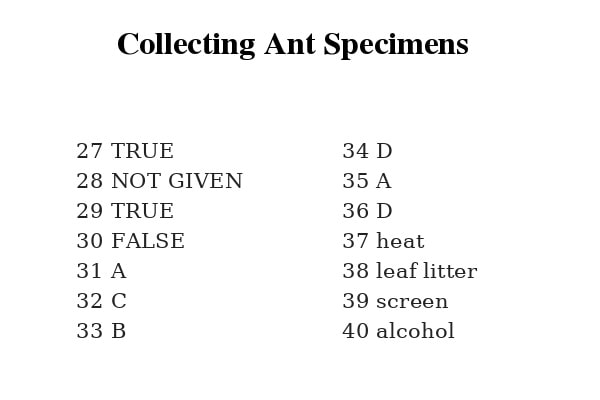Cambridge IELTS 8 is the latest IELTS exam preparation. sachvui.co will help you to answer all questions in cambridge ielts 8 reading test 4 with detail explanations.
Passage 1: LAND OF THE RISING SUN
Questions 1 – 5, choose the correct heading for sections B – F
1. Section B
In paragraph B, the writer gives us an overview about lower secondary schools in Japan such as the number of years [lower secondary schools in Japan cover three school years…private sector], the facilities [School are usually modern in design…in rows], the time of lessons [a standardized 50 minutes], break time [a 10 – minute break], classes are large and unstreamed. => This provides the background of secondary education in Japan. – lower secondary schools = middle – years education => ANSWER: vii – Background to middle – years education in Japan
2. Section C
In paragraph C: “Everyone has their own copy of the textbook supplied by the central education authority, Monbusho, as a part of the concept of free compulsory education up to the age of 15” => Monbusho, central education authority supplies textbooks. The last sentence in paragraph C: “Besides approving textbooks, Monbusho also decides the highly centralized national curriculum and how it is to be delivered”. This means that Monbusho has great effects/influence not only on textbooks but also the national curriculum. Moreover, the writer only refers to Monbusho in paragraph C. =>ANSWER: i – The influence of Monbusho
3. Section D
In paragraph D, the writer indicates the pattern for a math lessons: “Lessons all follow the same pattern. At the beginning, the pupils put solutions to the homework on the board, then the teachers comment, collect or elaborate as necessary”. => That means there is a typical format/pattern of a math lesson. format = pattern => ANSWER: v – The typical format of a math lesson
4. Section E
In paragraph E: “Teachers say that they give individual help at the end of a lesson or after school, setting extra work if necessary”. Moreover, “in observed lessons, any strugglers would be assisted by the teacher or quietly seek help from their neighbor”. That means teachers are willing to help students who have difficulties in learning. – less successful students = strugglers – help [to be helped] ~ be assisted by =>ANSWER: ii – Helping less successful students
5. Section F
In paragraph F, the writer raises a question in order to find out what factors contribute to the success of math education in Japan. “So what are the major contributing factors in the success of maths teaching? Clearly, attitudes are important”. Some other “relevant points relate to the supportive attitude of a class towards slower pupils, the lack of competition within a class, and the positive emphasis on learning….” – key = major contributing factors => ANSWER: viii – The key to Japanese successes in maths education
Questions 6-9
6. There is a wider range of achievement amongst English pupils studying maths than amongst their Japanese counterparts
Key words: wider range of achievement, English pupils, studying maths, Japanese counterparts In paragraph A: “but there was also a larger proportion of ‘low’ attainers in England, where, incidentally, the variation in attainment scores was much greater”. This means that though Japan has a significantly better record in terms of average mathematical attainment than England and Wales, England has a wider range of attainment scores than Japan. So, in England and Wales it is common for some pupils to achieve very high scores, while others only have low scores. – wider = greater – achievement = attainment counterpart: a person or thing that has the same position or function as somebody/something else in a different place or situation. => ANSWER: YES
7. The percentage of Gross National Product spent on education generally reflects the level of attainment
Key words: percentage, Gross National Product, spent, reflects, level of attainment The last sentence in paragraph A: “the percentage of Gross National Product spent on education is reasonably similar in the two countries, so how is this higher and more consistent attainment in maths achieved?” This means that though both countries [Japan & England] receive the same percentage of Gross National Product, the level of achievement in studying maths is higher in Japan. Moreover, in the first sentence, the writer indicates that Japan has a better record in mathematical attainment than England and Wales; therefore, it is false to say that the percentage of GNP spent on education reflects the level of attainment. => ANSWER: NO
8. Private schools in Japan are more modern and spacious than state – run lower secondary schools.
Key words: private schools in Japan, modern, spacious, state – run lower secondary schools In paragraph B, the writer indicates that : “all pupils attend state schools; only 3 per cent are in the private sector. Schools [state schools] are usually modern in design, set well back from the road and spacious inside”. This means that the writer states only that state schools are modern and spacious. We do not know whether private schools are more modern than state schools or not. – state – run lower secondary schools = state schools ANSWER: NOT GIVEN
9. Teachers mark homework in Japanese schools
Key words: teachers, mark, homework, Japanese schools In paragraph D: “Pupils mark their own homework: this is an important principle in Japanese schooling as it enables pupils to see where and why they made a mistake so that these can be avoided in future”. => This means that teachers do not mark homework. It is the students who mark their own homework. =>ANSWER: NO
Questions 10-13 Choose the correct letter, A,B,C or D.
10. Maths textbooks in Japanese schools are
In paragraph C: “These textbooks are, on the whole, small, presumably inexpensive to produce, but well set out and logically developed”. Textbooks are referred to again in paragraph D: “….the logical nature of the textbooks and their comprehensive coverage of different types of examples, combined with the relative homogeneity of the class, renders work sheets unnecessary”. Therefore, teachers do not need to use work sheets, the maths textbooks contain everything that the pupils need. – well organised = well set out – comprehensive coverage ~ containing all the examples that the pupils need =>ANSWER: B – Well organised and adapted to the needs of the pupils
11. When a new maths topic is introduced,
In paragraph D: “…. the teacher explains the topic of the lesson, slowly and with a lot of repetition and elaboration. Examples are demonstrated on the board; questions from the textbook are worked through first with the class….”. This means that when a new maths topic is introduced, the teacher patiently gives a clearly explanation of the topic to students. – patiently = slowly – carefully = with a lot of repetition and elaboration =>ANSWER: C- It is carefully and patiently explained to the students
12. How do schools deal with students who experience difficulties?
In paragraph E: “Teachers say that they give individual help at the end of a lesson or after school, setting extra work if necessary. In observed lessons, any strugglers would be assisted by the teacher or quietly seek help from their neighbour”. Schools also encourage parents to help: “Parents are kept closely informed of their children‟s progress and will play a part in helping their children to keep up with class, sending them to ‘Juku’ (private evening tuition) if extra help is needed and encouraging them to work harder”. – supplementary = extra tuition: the act of teaching something, especially to one person or to people in small groups =>ANSWER: A – They are given appropriate supplementary tuition
13. Why do Japanese students tend to achieve relatively high rates of success in maths?
In paragraph F: “maths is recognised as an important compulsory subject throughout schooling; and the emphasis is on hard work coupled with a focus on accuracy”. Maths is an important subject in Japanese schooling, Japanese students tend to learn hard/make a lot of effort and focus on the accuracy of answers => they tend to achieve high rates of success in maths – correct answers = accuracy – hard work = effort =>ANSWER: C – Much effort is made and correct answers are emphasised
CAMBRIDGE IELTS 8 – TEST 4 – PASSAGE 1 KEYWORDS TABLE
Passage 2: Biological control of pests
Questions 14 – 17 Choose the correct letter, A,B,C or D
14. The use of pesticides has contributed to
In paragraph 1: “Apart from engendering widespread ecological disorders, pesticides have contributed to the emergence of a new breed of chemical-resistant, highly lethal superbugs”. This means that the use of pesticides is partly responsible for widespread ecological disorders and the development of highly lethal superbugs ~ types of insects that are very difficult to destroy and which cause a lot of damage. This results in an imbalance in many ecologies around the world. – around the world = widespread – imbalance = disorders => ANSWER: B – an imbalance in many ecologies around the world.
15. The Food and Agriculture Organization has counted more than 300 agricultural pests which
In paragraph 2: “more than 300 species of agricultural pests have developed resistance to a wide range of potent chemicals”. That means pesticides no longer affect/ have any effect on these agricultural pests. – no longer responding to = have developed resistance to – pesticides = potent chemicals =>ANSWER: A – are no longer responding to most pesticides in use.
16. Cotton farmers in Central America began to use pesticides
Paragraph 4 refers to cotton farmers in Central America: “farmers avidly took to pesticides as a sure measure to boost crop yield”. That means farmers used pesticides to increase the amount of cotton harvested from each crop ~ the crop yield. – began to use = took to – boost: to make something increase =>ANSWER: D – to ensure more cotton was harvested from each crop
17. By the mid-1960s, cotton farmers in Central America found that pesticides
In paragraph 5: “By the mid-1960s, the situation took an alarming turn with the outbreak of four more new pests, necessitating pesticides spraying to such an extent that 50% of the financial outlay on cotton production was accounted for by pesticides”. This means that pesticides accounted for 50% of the amount of money spent on cotton production. – financial outlay: the money that you have to spend in order to produce cotton =>ANSWER: D – were costing 50% of the total amount they spent on their crops
Questions 18 – 21
18. Disease -spreading pests respond more quickly to pesticides than agricultural pests do.
Key words: disease-spreading pests, respond, more quickly, pesticides, agricultural pests. In paragraph 2, the FAO states that “more than 300 species of agricultural pests have developed resistance to a wide range of potent chemicals. Not to be left behind are the disease-spreading pests, about 100 species of which have become immune to a variety of insecticides now in use”. In this paragraph, the writer only refers to the number of species of both agricultural and disease – spreading pests which respond to pesticides. There is no mention of which type of pests develop resistance to pesticides more quickly. The information is not given. – respond to = develop resistance to – respond to = become immune to => ANSWER: NOT GIVEN
19. A number of pests are now born with an innate immunity to some pesticides
Key words: pests, born, innate immunity, pesticides In paragraph 3: “Because of their tremendous breeding potential and genetic diversity, many pests are known to withstand synthetic chemicals and bear offspring with a built-in resistance to pesticides”. That means these species are born with an innate immunity/ to insecticides. – born with ~ some pests give birth to young/offspring which are not killed by chemical pesticides – withstand ~ resist/be immune to/not be killed by – insecticides ~ chemicals/pesticides which kill insects innate: that you have when you were born =>ANSWER: YES
20. Biological control entails using synthetic chemicals to try and change the genetic make-up of the pests‟ offspring.
Key words: biological control, synthetic chemicals, change, genetic make-up, pests‟ offspring. In paragraph 7, “In the face of the escalating perils from indiscriminate applications of pesticides, a more effective and ecologically sound strategy of biological control, involving the selective use of natural enemies of the pest population, is fast gaining popularity – though, as yet, it is a new field with limited potential”. The writer states that „biological control‟ is a more effective and ecologically sound strategy, used in an effort to tackle the serious danger caused by the application of pesticides. This means that „biological control‟ does not use pesticides but uses natural enemies of pests. => It is false to say that “Biological control entails using synthetic chemicals to try and change the genetic make-up of the pests‟ offspring”. – peril: serious danger – indiscriminate: action that is taken without thought about what the result may be, especially when it causes people to be harmed =>ANSWER: NO
21. Bio-control is free from danger under certain circumstances
Key words: bio – control, free from, danger, circumstances In paragraph 7, the writer mentions “the advantage of biological control in contrast to other methods is that it provides a relatively low – cost, perpetual control system with a minimum of detrimental side – effects. When handled by experts, bio – control is safe, non – polluting and self – dispersing”. – Under certain circumstances [when handled by experts], bio-control is safe, non-polluting and self-dispersing = free from danger. =>ANSWER: YES
Questions 22 – 26
22. Disapene scale insects feed on
The last sentence in paragraph 9 explains that “CIBC is also perfecting the technique for breeding parasites that prey on ‘disapene scale’ insects – notorious defoliants of fruit trees in the US and India” => This means that disapene scale insects feed on fruit trees. – notorious: well known for being bad – defoliant: these insects eat the leaves from plants, in particular the leaves of fruit trees =>ANSWER: D – Fruit trees
23. Neodumetia sangawani ate
In paragraph 10: “Neodumetia sangawani, was found useful in controlling the Rhodes grass-scale insect that was devouring forage grass in many parts of the US”. This means Neodumetia sangawaniate ate Rhodes grass-scale insect to control it from devouring [eating] forage grass. To be clear, Neodumetia sangawani eats grass-scale insects, and grass-scale insects eat forage grass. – ate = was devouring =>ANSWER: H – Grass-scale insects
24. Leaf-mining hispides blighted
In paragraph 10: “In the late 1960s, when Sri Lanka‟s flourishing coconut groves were plagued by leaf-mining hispides, a larval parasite imported from Singapore brought the pest under control”. This means that Sri Lanka‟s coconut groves were damaged by leaf-mining hispides. – blight = plague – flourishing: developing quickly and being very successful/productive grove: a small group of trees => ANSWER: C – Coconut trees
25. An Argentinian weevil may be successful in wiping out
In paragraph 9, “Similarly the Hyderabad – based Regional Laboratory (RRL), supported by CIBC, is now trying out an Argentina weevil for the eradication of water hyacinth”. That means an Argentinian weevil may be successful in destroying all of the water hyacinth plants [by eating them] – hyacinth: a plant with a mass of small blue, white or pink flowers with a sweet smell that grow closely together around a thick stem – wiping out = eradication
26. Salvinia molesta plagues
In paragraph 10: “By using Neochetina bruci, a beetle native to Brazil, scientists at Kerala Agricultural University freed a 12-kilometer-long canal from the clutches of the weed Salvinia molesta…About 30,000 hectares of rice fields in Kerala are infested by this weed [Salvinia molesta]”. That means weed Salvinia molesta plagues about 30,000 hectares of rice fields in Kerala. – plague = infest =>ANSWER: B – Rice fields
CAMBRIDGE IELTS 8 – TEST 4 – PASSAGE 2 KEYWORDS TABLE
Passage 3: Collecting Ant Specimens
Questions 27-30: Do the following statements agree with the information given in Reading Passage 3?
27. Taxonomic research involves comparing members of one group of ants
Key words: taxonomic, comparing members of group of ants In paragraph 1: “For taxonomy, or classification, long series, from a single nest, which contain all castes (workers, including majors and minors, and, if present, queens and males) are desirable, to allow the determination of variation within species”. This means that taxonomic research involves classifying ants from a single nest, which contain all castes, or different members of a group. – comparing = determination of variation – one group = species =>ANSWER: TRUE
28. New species of ant are frequently identified by taxonomists.
Key words: new species of ant, identified, taxonomists All the information relating to taxonomic research is in paragraph 1. Taxonomic research involves comparing members of one group of ants and “the taxonomist sometimes overlooks whole species in favour of those currently under study”. There is no information about how often new species of ant are identified by taxonomists. => ANSWER: NOT GIVEN
29. Range is the key criterion for ecological collections
Key words: range, key criterion, ecological collections In paragraph 1, “For ecological studies, the most important factor is collecting identifiable samples of as many of the different species present as possible”. This means that it is important for ecological collections to collect a variety of present species [collect different species] – range: a variety of things of a particular type – key criterion = the most important factor => ANSWER: TRUE
30. A single collection of ants can generally be used for both taxonomic and ecological purposes.
Key words: single collection of ants, taxonomic and ecological purposes In paragraph 1: “For ecological studies, the most important factor is collecting identifiable samples of as many of the different species present as possible”. Taxonomists prefer to collect a lot of ants from a single nest. “Unfortunately, these methods are not always compatible”. Therefore, one collection of ants cannot always be used for both purposes. Therefore, it is false to say that a single collection of ants can generally be used for both taxonomic and ecological purposes. => ANSWER: FALSE
Questions 31 – 36
31. It is preferable to take specimens from groups of ants
In paragraph 2, in the hand collecting method, “when possible, collections should be made from nests or foraging columns and at least 20 to 25 individuals collected. This will ensure that all individuals are from the same species and so increase their value for detailed studies”. “Take specimens from groups of ants” means all individuals [ants] are the same species, from the same nestor column of ants searching for food. =>ANSWER: A – Hand-collecting
32. It is particularly effective for wet habitats.
In paragraph 4, in the ground litter sampling method, “this method works especially well in rain forests and marshy areas”. Rain forests and marshy areas are wet habitats. – effective = works well – marshy area: land which is always soft and wet. => ANSWER: C – Sampling ground litter
33. It is a good method for species which are hard to find
In paragraph 3, in the method using baits, “Baits can be used to attract and concentrate foragers. This often increases the number of individuals collected and attracts species that are otherwise elusive”. That means baits can be used to collect species which are hard to find [elusive]. – hard to find = elusive =>ANSWER: B – Using bait
34. Little time and effort is required
In paragraph 5, the pitfall trap method, “One advantage of pitfall traps is that they can be used to collect over a period of time with minimal maintenance and intervention”. That means when using pitfall traps, little time and effort is required to look after and check the traps [this is the advantage of this method]. – little = minimal: very small in size or amount; as small as possible =>ANSWER: D – Using a pitfall trap
35. Separate containers are used for individual specimens
In paragraph 2, in the hand collecting method, “Individual insects are placed in plastic or glass tubes (1.5 – 3.0 ml capacity for small ants, 5-8 ml for larger ants) containing 75% to 95% ethanol”. Insects [including small ants and larger ants] are placed in plastic or glass tubes [containers] with different sizes. Each insect is placed in a separate tube. – containers = tubes =>ANSWER: A – Hand collecting
36. Non-alcoholic preservative should be used
In paragraph 5, in the method using pitfall traps, “the preservative used is usually ethylene glycol or propylene glycol, as alcohol will evaporate quickly and the traps will dry out”. If alcohol is used to preserve ant speciments, the traps dry too quickly because alcohol evaporates. So other preservatives, which do not contain alcohol should be used. – evaporate: to disappear, especially by gradually becoming less and less => ANSWER: D – Using a pitfall trap
Questions 37 – 40
In paragraph 4: “This is most commonly done by placing leaf litter [38] on a screen [39] over a large funnel, often under some heat [37]. As the leaf litter dries from above, ants (and other animals) move downward and eventually fall out the bottom and are collected in alcohol [40] placed below the funnel”
CAMBRIDGE IELTS 8 – TEST 4 – PASSAGE 3 KEYWORDS TABLE

Cambridge ielts 1-16 reading test solutions
Cambridge IELTS Reading KEYWORDS Table
IELTS Reading Practice Test
Cambridge IELTS 8 Self-study Pack (Student’s Book with Answers and Audio CDs (2)) Official Examination Papers from University of Cambridge ESOL Examinations


